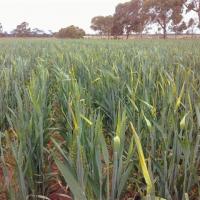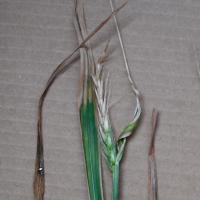Diagnosing copper deficiency in wheat
Most soils in Western Australia (WA) were copper deficient in their natural state. Copper is essential for pollen formation and has a role in formation of chlorophyll and lignification (cell wall strength). Deficiency causes sterile pollen, which, in turn causes poor grain formation and high yield losses.
What to look for
- Before head emergence deficiency shows as areas of pale, wilted plants with dying new leaves in an otherwise green healthy crop.
- After head emergence mildly affected areas have disorganised wavy heads. Severe patches have white heads and discoloured late maturing plants.
- Symptoms are often worse on sandy or gravelly soils, where root pruning herbicides have been applied and recently limed paddocks.
Paddock
- Youngest growth is affected first.
- First sign of copper deficiency before flowering is growing point death and tip withering, and/or bleaching and twisting up to half the length of young leaves.
- Base of the leaf can remain green.
- Old leaves remain green, but paler than normal.
- Tiller production may increase but die prematurely.
- Mature plants are dull grey-black in colour with white or stained empty or 'rat-tail' heads.
- Grain in less severely affected plants may be shrivelled. Heads with full grain droop due to weak stems.
Plant
What else could it be
| Condition | Similarities | Differences |
|---|---|---|
| Diagnosing false black chaff in wheat | Discouration on the upper stem and glumes | False black chaff does not affect yield or grain quality |
| Diagnosing molybdenum deficiency in cereals | White heads and shrivelled grain | Molydenum deficiency affects middle leaves first rather than the youngest leaf |
| Diagnosing boron deficiency in wheat | Youngest leaf death | Boron deficient plants are dark rather than light green and affected leaves have marginal notches and split near the base |
| Diagnosing stem and head frost damage in cereals | White heads, shrivelled grain, late tillers and delayed maturity | Spring frost does not cause death or twisting of the flag leaf and is location specific (frost-prone areas) |
| Diagnosing take-all in cereals | White heads and shrivelled grain | Take-all causes blackened roots and crowns and often kills the plant |
Where does it occur?

Soil type

Dry conditions
- Most sandy surfaced soils required copper and zinc when initially cleared for agriculture.
- Copper is relatively immobile in soil and can become unavailable to crops in dry soil.
- Where copper soil levels are marginal, deficiency can be induced by applications of lime, increased nitrogen fertiliser and zinc fertiliser.
- The use of root-pruning herbicides, particularly groups A and B can induce copper deficiency.
Management strategies

Spraying foliar
- Foliar spray (only effective in the current season) or drilled soil fertiliser.
- Copper foliar sprays are not effective after flowering as sufficient copper is required pre-flowering for pollen development.
- Mixing copper throughout the topsoil improves availability due to more uniform nutrient distribution.
- As copper is immobile in the soil topdressing is ineffective, only being available to the plant when the topsoil is wet.
- In long term no-till paddocks frequent small applications of copper via drilled or in-furrow application reduces the risk of plant roots not being able to obtain the nutrient in dry seasons.
- Copper drilled deep increases the chances of roots being able to obtain enough copper when the topsoil is dry.
- Copper seed treatment is insufficient to for plant requirement in the current season.
How can it be monitored?

Tissue test
- A DTPA soil test is not sufficiently calibrated and provides at best a rough guide to soil copper status.
- Whole-top plant test provides a rough guide if paired good/ poor samples are taken, but this should be confirmed with a youngest emerged blade (YEB) test.
- YEB levels below 1.5 milligrams per kilogram (mg/kg) indicate copper deficiency.
- Copper deficiency may be confirmed by submitting samples of affected heads containing grain and unaffected heads for grain analysis.
- Grain levels below 1.2mg/kg indicate copper deficiency.
See also
Further information
Where to go for expert help
Page last updated: Friday, 29 May 2015 - 2:04pm





